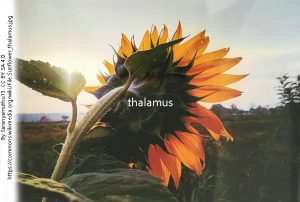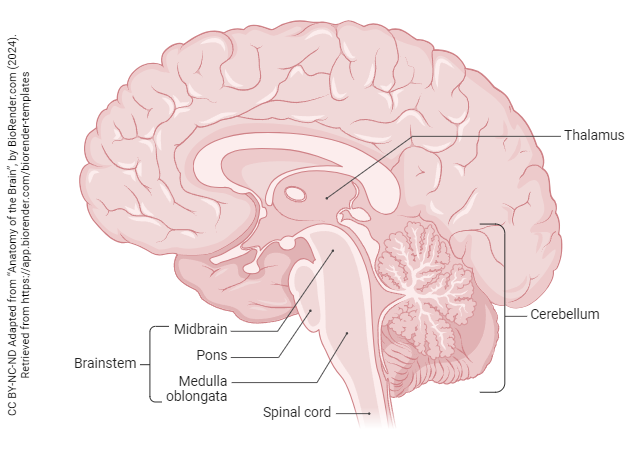The Thalamus
Rachel Jessop and Jim Hutchins
Objective
1. Explain the significance and location of the thalamus.
 The word thalamus was named by the neuroscientists of the Enlightenment and refers to the Latin word for “inner chamber” or “bedroom” with the additional implication of the marriage bed. Even though they were naming parts of the brain based on appearance, by lucky accident the thalamus and (just underneath it) the hypothalamus were appropriately named. The thalamus is the place where our innermost thoughts either flower in the cerebral cortex (because cortex = consciousness), or are stopped before they can become conscious thoughts. Conscious movement is shaped and smoothed by motor circuits running through the thalamus. Almost all homeostatic loops, the circuitry and chemistry that keeps the body’s systems in balance, are routed through the hypothalamus. In fact, while you might have been taught as a child that the pituitary is the “master gland” of the human body, the pituitary has a master — the hypothalamus. (Who is the hypothalamus’ master? Well, a committee, of course.)
The word thalamus was named by the neuroscientists of the Enlightenment and refers to the Latin word for “inner chamber” or “bedroom” with the additional implication of the marriage bed. Even though they were naming parts of the brain based on appearance, by lucky accident the thalamus and (just underneath it) the hypothalamus were appropriately named. The thalamus is the place where our innermost thoughts either flower in the cerebral cortex (because cortex = consciousness), or are stopped before they can become conscious thoughts. Conscious movement is shaped and smoothed by motor circuits running through the thalamus. Almost all homeostatic loops, the circuitry and chemistry that keeps the body’s systems in balance, are routed through the hypothalamus. In fact, while you might have been taught as a child that the pituitary is the “master gland” of the human body, the pituitary has a master — the hypothalamus. (Who is the hypothalamus’ master? Well, a committee, of course.)
Some authorities include the thalamus as part of the brainstem; others consider the thalamus to sit atop the brainstem. Either way, the thalamus is an area that relays information going up to cortex, and relays information leaving cortex on its way to the brainstem or spinal cord.


